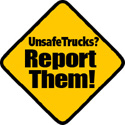Facts and Figures
National | General Roadway Facts
“Based on their numbers on the road and the amount they travel, large trucks (tractor-trailers, single-unit trucks, and some cargo vans weighing more than 10,000 pounds) account for more than their share of highway deaths. Large trucks have higher fatal crash rates per mile traveled than passenger vehicles, although a higher percentage of large truck travel occurs on interstates, the safest roads. Most deaths in large truck crashes are passenger vehicle occupants rather than occupants of large trucks. The main problem is the vulnerability of people traveling in smaller vehicles. Trucks often weigh 20-30 times as much as passenger cars.”—Insurance Institute for Highway Safety
About Big Trucks
Fully loaded, a tractor-trailer may weigh as much as 80,000 pounds and can be over 65 feet long. This Asignificantly affects their on-road capabilities:
Brakes. At 55 mph, a car can usually stop within 130 to 140 feet. A loaded big rig can take 190 to 200 feet to stop, or as much as 450 feet if its brakes are hot from repeated use.
 Acceleration. Because of their weight,
big rigs take longer to reach cruising speed than passenger
vehicles. This obviously makes it more difficult for
a trucker to climb hills or rapidly move from lane to
lane.
Acceleration. Because of their weight,
big rigs take longer to reach cruising speed than passenger
vehicles. This obviously makes it more difficult for
a trucker to climb hills or rapidly move from lane to
lane.
Visibility. Tractor-trailers have large blind spots in the rear, on both sides and even in front of the cab. The rear blind spot can be 200 feet deep; on the sides, it can extend past the end of the trailer and in front, it can be as far as 20 feet.
Maneuverability. Big rigs need extra room to make turns. Drivers often move to the left to make a right turn. Also, on multi-lane roads truckers prefer the middle lane because it gives them more maneuvering options in case of an emergency ahead. Cars can swerve or duck trouble more readily than a large truck.
National
- In 2003, there were 58,512 total vehicles involved in fatal crashes in the U.S.
- Of those, 4,669 were fatal crashes involving large trucks.
- Large trucks are more likely to be involved in a fatal multi-vehicle crash than are passenger vehicles.
- Most fatal truck crashes occurred in rural areas (68 percent) during the daytime (66 percent) and on weekdays (78 percent).
- About 27 percent of all large truck drivers involved in fatal truck crashes had at least one prior speeding conviction compared to 19 percent of the passenger vehicle drivers involved in fatal crashes.
Source: NHTSA Fatal Analysis Reporting System (FARS) and Federal Motor Carrier Safety Administration (FMCSA)
Roadway Facts
- 5,212 people were killed in crashes involving large trucks in 2005, representing about 12-13 percent of all traffic fatalities. Of these, 78 percent were occupants of another vehicle, 15 percent were large truck occupants, and 9 percent were non-occupants. An additional 114,000 people were reported injured in those crashes (based on data published in 2004 Projections, National Highway Traffic Safety Administration (NHTSA), April 21, 2005),
- The annual death toll from truck-related crashes is the equivalent of 52 major airline crashes every year, one crash every week resulting in 95 deaths.
- Large trucks are 9 percent of all vehicles involved in fatal crashes and represent 11-13 percent of all crash fatalities despite the fact that large trucks make up only 3 percent of all registered vehicles (Insurance Institute for Highway Safety (IIHS), 2001-2006; NHTSA, 2001-2005).
- The fatality rate for big combination truck (tractor-trailer) crashes in 2005 was 2.34 per 100 million vehicle miles traveled (MVMT), almost double the rate for passenger vehicles (1.14 per 100 million vehicle miles traveled) (NHTSA 2005, FMCSA 2007).

